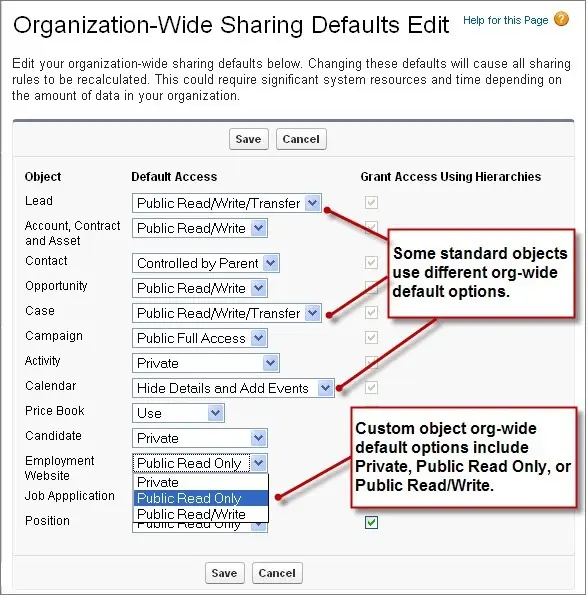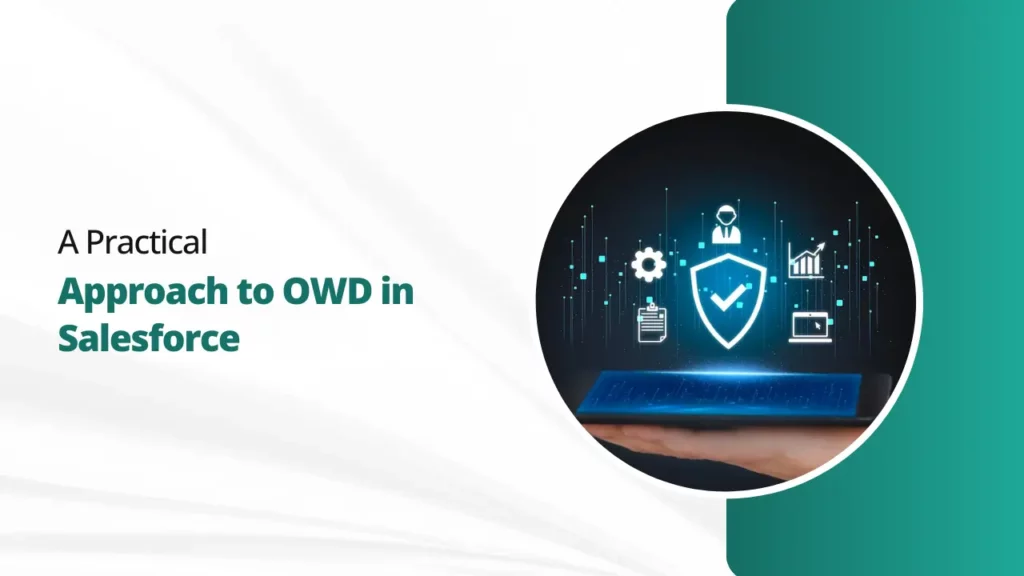Managing data access is a critical aspect of ensuring the security of your organization’s information. One of the key tools in this endeavour is the Organization-Wide Defaults (OWD) settings. As organizations use Salesforce for their operations, an understanding of how to wield the power of OWD in Salesforce becomes important for effective data management. In this blog post, we’ll discuss the practical approach to OWD in Salesforce. We will explore its significance, best practices, and strategies for effective implementation.
OWD in Salesforce
Organization-wide defaults govern the baseline access level for records across your Salesforce organization. They establish the foundation for record visibility. They also control who can view and edit records within your Salesforce environment. OWD settings are pivotal in maintaining data privacy. They ensure that sensitive information is only accessible to authorized users.

The Significance of OWD in Data Security
- Data Integrity: OWD settings play a crucial role in maintaining the integrity of your Salesforce data. It ensures that users only interact with the information relevant to their roles and responsibilities.
- Compliance and Privacy: In an era of stringent data protection regulations, such as GDPR and CCPA, OWD has become a key ally in achieving compliance. It enables organizations to modify data access to align with privacy regulations.
Practical Strategies for OWD Implementation
- Assess Your Organization’s Needs: Begin by conducting a thorough analysis of your organization’s structure. Understand the data access requirements for different user groups.
- Define Clear Data Ownership: Clearly define ownership of records to establish accountability. Assign record ownership based on roles and responsibilities. This ensures that the right individuals have control over specific sets of data.
- Hierarchy-Based Access: Use role hierarchies to streamline data access. This ensures that users can access records owned by individuals below them in the hierarchy. It creates a natural flow of information within the organization.
- Utilize Sharing Rules: Supplement OWD settings with sharing rules to extend access selectively. Sharing rules provides a fine-grained control mechanism. It allows you to open up access to specific records based on criteria you define.
- Review and Refine Settings: As your organization evolves, so do its data access requirements. Regularly review and refine your OWD settings to align with organizational changes and processes.
- Dynamic Permission Sets: Implement dynamic permission sets to adapt to changing user roles. These sets can be adjusted as individuals move within the organization. This initiative ensures that users have the necessary access rights without compromising security.
- Utilize Public Groups:
Public groups in Salesforce can be powerful allies in refining data access. Use public groups to grant access to specific sets of records to a defined group of users. This facilitates collaboration among cross-functional teams.
- Custom Profiles for Specialized Access:
Create custom profiles tailored to specific user groups with unique data access needs. This allows for granular control over record visibility. It also ensures that different departments or teams see only the information relevant to their functions.
- Criteria-Based Sharing Rules:
Go beyond standard sharing rules by implementing criteria-based sharing rules. This advanced feature enables you to define conditions under which records are shared. It provides a more nuanced approach to extending access based on specific attributes.
- External Sharing Models:
If your organization collaborates extensively with external partners or customers, explore the possibilities offered by external sharing models. Define secure ways to share data beyond organizational boundaries. But also maintain strict control over the information shared.
Best Practices for OWD Maintenance
- Document Your OWD Strategy: Maintain comprehensive documentation of your OWD strategy. This documentation serves as a valuable resource for administrators and auditors.
- Provide Ongoing Training: Ensure that users are educated on the data access model in place. Training sessions can help users understand their access levels. This fosters a culture of data responsibility.
- Monitor and Audit Access: Implement regular access audits to identify and rectify any discrepancies. Monitoring user activities ensures that the established OWD settings are preventing unauthorized access.
Conclusion
OWD in Salesforce is essential for maintaining an effective data security posture. Understanding OWD and implementing effective strategies helps a lot in data security. By using best practices, organizations can strike a balance between data accessibility and security. In doing so, they empower their teams to work efficiently while safeguarding sensitive information per regulatory requirements. Use OWD in Salesforce to use the full potential of Salesforce data management in your organization.
If you need any assistance related to OWD in Salesforce Pardot, contact us.
FAQs
What is the purpose of the OWD in Salesforce?
The purpose of OWD (Organization-Wide Defaults) in Salesforce is to define the baseline level of access for records.
Can we deploy OWD in Salesforce?
Yes, OWD settings can be configured and deployed in Salesforce to establish the default level of record access across the organization.
What is the difference between profile and OWD?
Profiles in Salesforce control access at the object and field levels for a user, while OWD defines the baseline access for records across the entire organization.
Is OWD record level or object level security?
OWD primarily governs record-level security in Salesforce, specifying who can access specific records. It does not control access to entire objects.
What are the limitations of OWD in Salesforce?
Limitations of OWD include its inability to provide granular control for individual records and exposure of sensitive data due to broad access settings.




